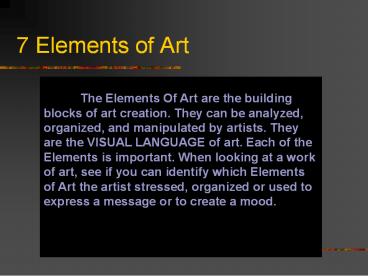7 Elements of Art - PowerPoint PPT Presentation
Title:
7 Elements of Art
Description:
The Elements Of Art are the building blocks of art creation. They can be analyzed, organized, and manipulated by artists. They are the VISUAL LANGUAGE of art. – PowerPoint PPT presentation
Number of Views:139
Avg rating:3.0/5.0
Title: 7 Elements of Art
1
7 Elements of Art
2
Ben Shahn Supermarket
Songya People kifwebe mask
Kathe Kollwitz Self-Portrait
Kenneth Snelson Needle Tower
3
Line
- A line is a basic element of art, referring to a
continuous mark, made on a surface, by a moving
point.
- How many types of lines can you make? How
important are lines to our environment? The
artist recognizes the power of the "Line" when he
or she creates a work of art.
4
What element catches your eye?
MerryGoRound
Piet Mondrian Broadway Boogie-Woogie
5
Color
- Many people would argue that the Element of
"Color" has the most effect on a work of art.
Consider what our world would look like if
everything was black, white and shades of gray?
The effects of "Color" on humans has been studied
many times. Artists have known that "Color" has a
powerful effect on their works and on the
impressions of the viewers.
6
Color wheel
- Primary colors
- Secondary colors
- Tertiary colors
- Complimentary colors
- Hue
- purest form of a color
7
Shanon Fitzpatrick Coral Study
Gustav Klimt Emilie Floge
Paul Klee Ad Parnassem
8
Texture
- An element of art which refers to the surface
quality or "feel" of an object, its smoothness,
roughness, softness, etc. Textures may be actual
or simulated. Actual textures can be felt with
the fingers (tactile), while simulated textures
(visual) are suggested by the way the artist has
painted certain areas of a picture.
9
Louise Nevelson Sky Cathedral
Korean Nok masks
Joan Miro The Policeman
Henri Matisse
Cut Paper Collage
10
Shapes
- Shapes are everywhere. More common ones are given
names such as circle or square. There are an
infinite amount of shape possibilities and
combinations. - Two Types (2-D)
- Organic
- Geometric
11
- Specifically, it is an enclosed space, the
boundaries of which are defined by other elements
of art (i.e. lines, colors, values, textures,
etc.). - Shapes are limited to two dimensions length and
width. Geometric shapes - circles, rectangles,
squares, triangles and so on - have the clear
edges one achieves when using tools to create
such shapes. Organic shapes have natural, less
well-defined edges (think an amoeba, or a cloud).
12
Sandy Skoglund Radioactive Cats
Michelangelo Buonoratti David
Frank Gehry
Alexander Calder Mobile
13
Form
- Forms are often called the "three-dimensional
shapes". Unlike flat, two-dimensional areas,
Forms are represented as "three-dimensional". The
great illustrators and sculptors of the world of
art have mastered the Element Form.
14
Henry Moore Reclining Figure
Paul Cezanne The basket of Apples
Salvador Dali The Deterioration of The
Persistence Of Memory
Andrew Wyeth Christinas World
15
Space
- Often we do not consider Space when we create a
work of art. It often just seems to happen. Space
creates interest in an artwork. - Two Types
- Positive ()
- Negative (-)
16
Ferdinand Leger
Marc Chagall
17
Value
- Value refers to the lightness or darkness of a
color. It also refers to how artists use other
Elements Of Art to create a sense of light or
dark. - Different Values
- Tint
- Tone
- Shade
18
Review
- Line
- Shape
- Space
- Form
- Texture
- Color
- Value































